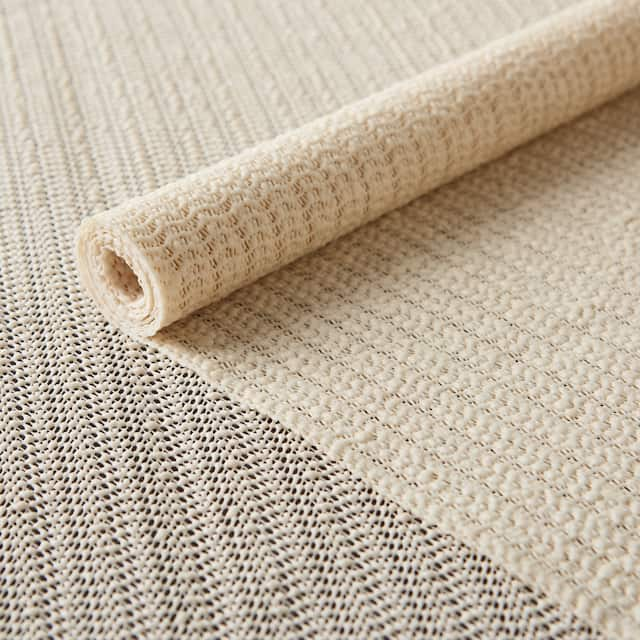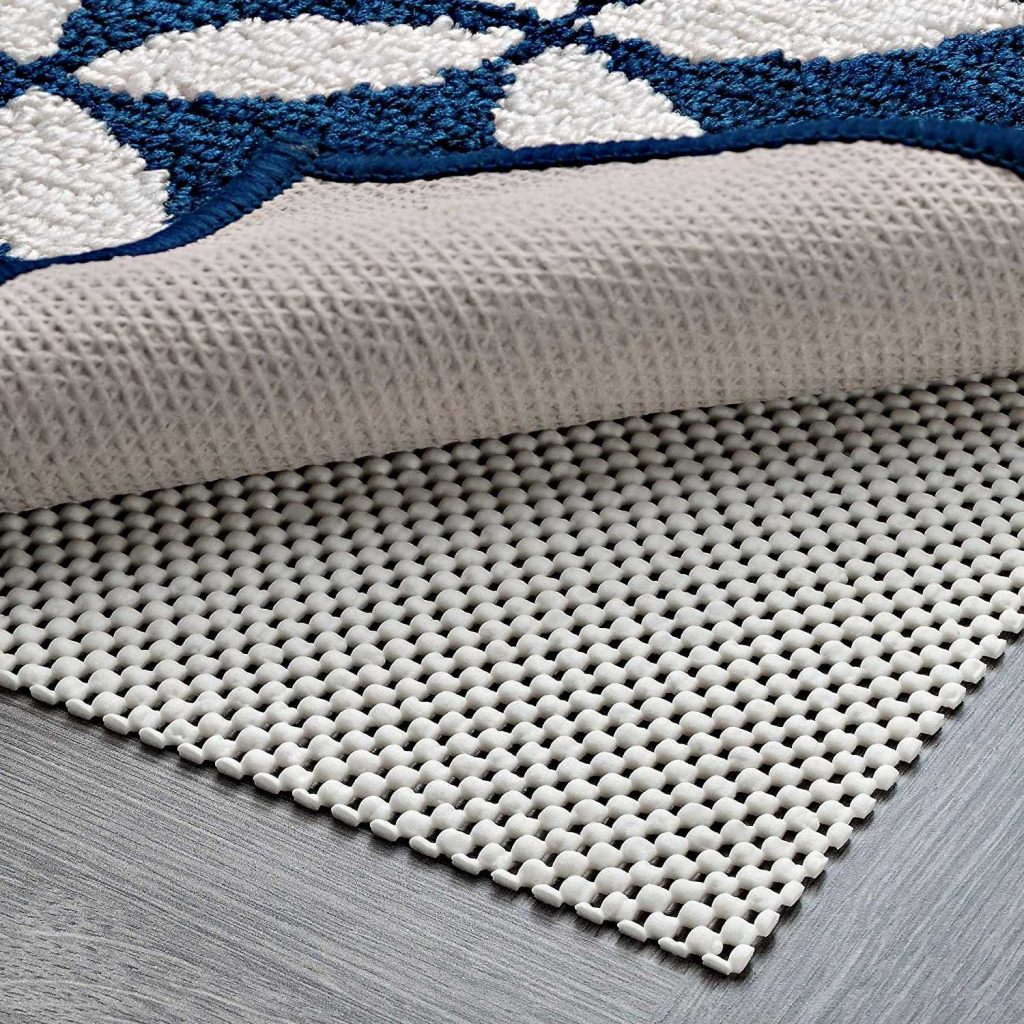Imagine this: You’re walking across your living room, enjoying a cozy evening with a cup of tea, when suddenly, your rug slides out from under you. You tumble to the floor, feeling a sharp jolt of pain and a surge of fear. This scenario, unfortunately, is far too common, especially for those with hardwood floors. But fret not! The solution lies in non-slip rug pads.

Image: www.overstock.ca
These unsung heroes, made from a variety of materials, are designed to anchor rugs firmly to the floor, preventing those dreaded slips and falls. In this guide, we’ll dive deep into the world of rug pads, exploring the various types, comparing their pros and cons, and providing expert insights to help you choose the perfect pad for your home.
Understanding the Need: Why You Need a Non-Slip Rug Pad
While wood floors offer elegance and durability, they can also be slippery, transforming your home into a virtual skating rink. The smooth surface of hardwood creates a frictionless environment for rugs, making them prone to movement. Even with rugs that have rubberized backing, sometimes it’s not enough to truly keep them secure.
Beyond the risk of falls, slippery rugs can become a nuisance, constantly shifting and bunching up, ruining the aesthetic appeal of your carefully curated décor. This is where non-slip rug pads come in as the ultimate solution, offering a sense of peace of mind and a harmonious living space.
Choosing the Right Rug Pad: A Guide to Materials and Features
The rug pad market is filled with a dizzying array of options, each offering a unique combination of features and benefits. To choose the best pad for your needs, you must consider the specific requirements of your flooring, rug, and lifestyle.
1. Rubber Rug Pads: The Reliable Choice
Most commonly found in the market, rubber rug pads are known for their durability and excellent grip. This versatile material provides a strong non-slip surface, effectively anchoring even the heaviest rugs to wood floors. The thick, cushioned layer also adds a layer of comfort to your rug, protecting it from wear and tear.
While rubber pads offer reliable performance, consider their tendency to shed rubber particles, creating a black residue on your floors. This concern is less prominent with high-quality rubber pads but requires occasional cleaning to maintain their effectiveness.

Image: rugcritic.com
2. Foam Rug Pads: A Soft and Quiet Option
Foam rug pads are characterized by their soft and cushioned feel, delivering a gentle springiness under your feet. The dense foam provides comfortable support, reducing strain on your feet and joints while creating a sound dampening effect. This feature is particularly beneficial for households with children or pets, making it easier to maintain a peaceful environment.
While foam pads offer exceptional comfort and noise reduction, they may not offer the same level of grip as rubber pads. So, if you have a particularly slippery rug or live in a highly active household, consider opting for a rubber or combined foam-rubber pad.
3. Gel Rug Pads: The Ultimate Comfort and Grip
For a superior grip and extra cushioning, gel rug pads offer an unmatched experience. These innovative pads feature a gel core that conforms to the shape of your rug, providing a secure hold and luxurious feel. The gel material also serves as a shock absorber, protecting your rug and floors from scratches and dents.
While gel pads offer a premium experience, they come at a higher price point than other types of pads. They are also more susceptible to dents and tears, requiring careful handling and maintenance.
4. Natural Fiber Rug Pads: Eco-Friendly and Sustainable
For those conscious of their environmental impact, natural fiber rug pads offer a sustainable and eco-friendly choice. Made from materials like jute, hemp, or wool, these pads provide excellent grip and a natural aesthetic. Natural fibers are renewable and biodegradable, adding to their sustainability appeal.
Although natural fiber rug pads are a responsible choice, they may not offer the same level of durability or longevity as synthetic pads. They also tend to be more expensive than traditional rubber or foam pads.
Factors to Consider When Choosing a Rug Pad
Now that we have explored the different types of rug pads, it’s time to dive into the key factors you should consider when making your selection.
1. Rug Material and Size: Finding the Perfect Match
The choice of rug pad will depend largely on the type of rug you own. For heavy, plush rugs made of wool or silk, a thicker, more robust pad with excellent grip is essential. For lighter rugs made of cotton or synthetic materials, a thinner, more lightweight pad might be sufficient.
The size of your rug is also crucial. Ensure that the rug pad is slightly smaller than the rug to prevent it from bunching up around the edges.
2. Flooring Type: Matching the Pad to the Surface
Your flooring type plays a significant role in determining the type of rug pad needed. For highly polished hardwood floors, a non-slip pad with a strong grip is necessary to prevent the rug from sliding.
For natural wood floors with a less polished finish, a softer, more cushioned pad might be a better choice to prevent scratching.
3. Lifestyle Considerations: Ensuring Durability and Safety
Your lifestyle should also guide your decision. In a household with young children or furry companions, durability and safety are paramount. Choose a rug pad that can withstand heavy traffic and resist wear and tear.
For individuals with allergies, opt for a hypoallergenic rug pad made from natural fibers or synthetic materials that are less likely to trigger allergic reactions.
Expert Insights and Actionable Tips: Making the Right Choice
To guide your decision-making process, we consulted with interior designers and rug experts, who shared their invaluable insights.
- Prioritize Quality: When choosing a rug pad, prioritize quality over price. Look for a pad made from durable materials and designed for the specific needs of your rug and flooring.
- Invest in a Good Grip: Ensure the rug pad offers a strong grip, preventing your rug from shifting and creating a safe environment.
- Consider the Size and Shape of the Room: Select a rug pad that is slightly smaller than your rug to prevent bunching and ensure a seamless fit.
- Replace Your Rug Pad Regularly: Over time, rug pads can lose their effectiveness. Replace them every 2-3 years to maintain a safe and effective grip.
Best Non Slip Rug Pad For Wood Floors
Conclusion: Elevating Your Home with the Power of a Rug Pad
Non-slip rug pads are essential for anyone with hardwood floors, offering a safe, comfortable, and aesthetically pleasing environment. By understanding the different types, features, and factors to consider, you can choose the perfect pad to protect your rug, safeguard your loved ones, and elevate the beauty of your home.
Don’t let slippery rugs be a hazard in your home. Explore the world of rug pads, find the perfect match for your needs, and enjoy the peace of mind and elegance they provide.






